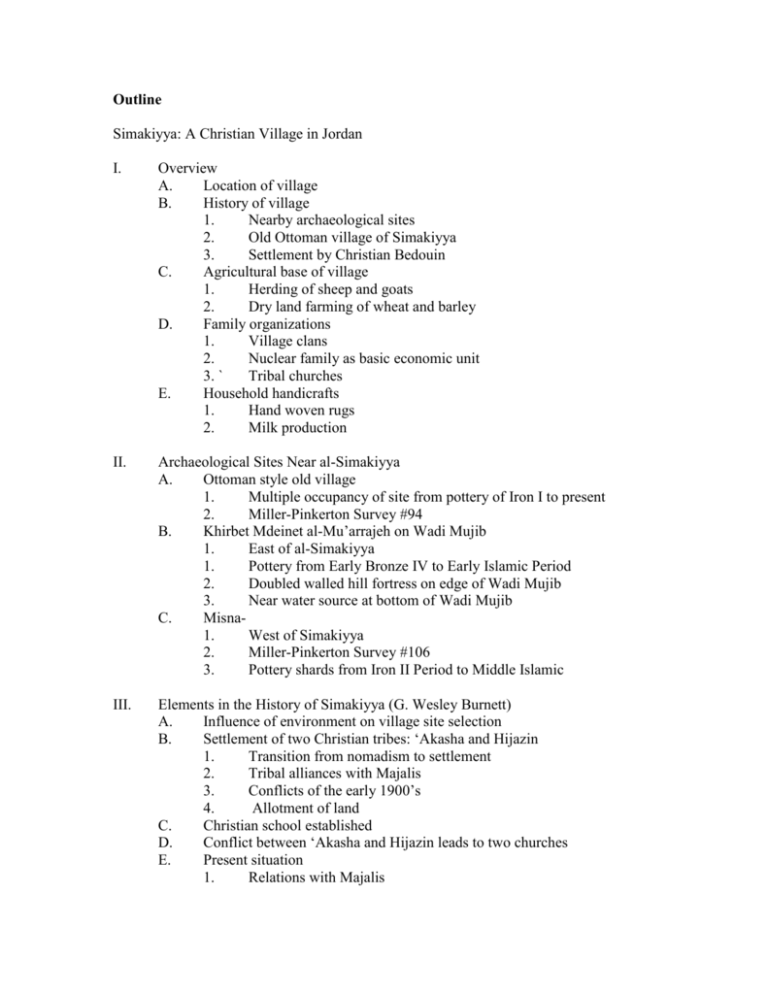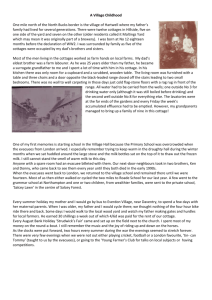outline in Word 2000 format
advertisement

Outline Simakiyya: A Christian Village in Jordan I. Overview A. Location of village B. History of village 1. Nearby archaeological sites 2. Old Ottoman village of Simakiyya 3. Settlement by Christian Bedouin C. Agricultural base of village 1. Herding of sheep and goats 2. Dry land farming of wheat and barley D. Family organizations 1. Village clans 2. Nuclear family as basic economic unit 3. ` Tribal churches E. Household handicrafts 1. Hand woven rugs 2. Milk production II. Archaeological Sites Near al-Simakiyya A. Ottoman style old village 1. Multiple occupancy of site from pottery of Iron I to present 2. Miller-Pinkerton Survey #94 B. Khirbet Mdeinet al-Mu’arrajeh on Wadi Mujib 1. East of al-Simakiyya 1. Pottery from Early Bronze IV to Early Islamic Period 2. Doubled walled hill fortress on edge of Wadi Mujib 3. Near water source at bottom of Wadi Mujib C. Misna1. West of Simakiyya 2. Miller-Pinkerton Survey #106 3. Pottery shards from Iron II Period to Middle Islamic III. Elements in the History of Simakiyya (G. Wesley Burnett) A. Influence of environment on village site selection B. Settlement of two Christian tribes: ‘Akasha and Hijazin 1. Transition from nomadism to settlement 2. Tribal alliances with Majalis 3. Conflicts of the early 1900’s 4. Allotment of land C. Christian school established D. Conflict between ‘Akasha and Hijazin leads to two churches E. Present situation 1. Relations with Majalis 2. 3. 4. Environmental conditions: drought and rainfall amounts Out migration of youth Arrival of piped water IV. Shepherding in al- Simakiyya A. Relations between Christian villagers and Moslem Bedouin herders B. Herd management 1. Herding schedule 2. Location of grazing 3. Organization of herds from several households C. Personal situation of one village herder, Oday 1. Family arrangement 2. Amount of income 3. Managing his personal herd D. Herding strategies 1. Use of bells 2. Employment of the donkey and not dogs E. Type of sheep and goats A. Benefits of sheep over goats for field grazing B. Benefits of goats over sheep in rough terrain F. Agreements and relations with village farmers and land owners G. Herd care 1. Care of the rams 2. Controlling mating behavior H. Symbiotic relationship between villagers and herders V. Bread Baking A. Tradition of bread baking in the village B. Construction of outdoor ovens 1. Clay ovens found in archaeological sites 2. Form and materials used in oven construction 3. Animal dung as a fuel source C. Process of bread baking 1. Preparation of dough 2. Number of loaves 3. Length of baking 4. Other activities while baking VI. Household Milk Production A. Maintaining the tradition of food self-sufficiency B. Milking schedule of sheep and goats 1. Daily schedule: early morning and evening 2. Spring milking versus summer milking 3. Household demand of average size family C. Milk processing of sheep-goat milk C. 1. Cleaning the fresh milk and production of yogurt 2. Use of wash machine to separate milk 3. Processing of butter 4. Processing of low fat milk into cheese 5. Turning butter into clarified butter 6. Making white cheese Future of milking and women’s contribution to household economy 1. Continuation of tradition of milking by youth 2. Commercial rural processing plants VII. Weaving Rugs A. Loss of weaving tradition in the village 1. Selling of family heirlooms 2. Concern about loss of craft 3. Proposal to look for funding for weaving center B. Weaving outside of the village 1. Egyptian weavers in Karak city 2. Weaving by Bedouins for tent materials C. Process of weaving 1. Wool from sheep and hair from goats – mostly goat hair 2. Traditional spinning techniques 3. Ground loom worked by group of women 4. Traditional colors and designs D. Excerpts from article by Dr. Raid Al-Baqain on textile production VIII. Introduction to the Contemporary Studies Team (CST)






